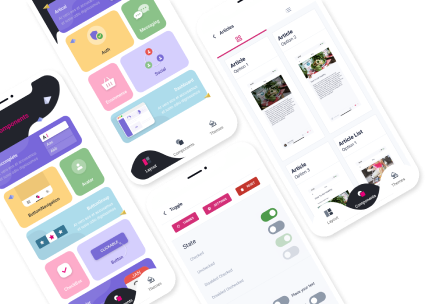5 Tips for Effectively Managing an Outsourcing Software Development
Nowadays, more and more companies choose outsourcing software development for their business needs. With perks like reduced costs, easier access to talent, and potentially faster time to plug, it's no surprise that outsourcing is gaining traction. A number of the extra benefits of outsourced projects are that it allows specializing in the core business, resolving capacity issues, and improving the service quality.
Nevertheless, there are always several challenges and risks when it comes to outsourcing software development. That’s why software development management techniques play an important role in the success of your outsourced projects. This article will provide you with useful tips to help you keep your outsourcing software development on track.
What is Software Outsourcing?

Before diving into the intricacies of the process, let's define what outsourcing means
Outsourcing is a corporate engineering practice in which a third-party vendor is assigned a company task, process, function, or component. The supplier can be an individual or a company, depending on the nature of the operation. Outsourcing is used most often in the IT sector globally today.
Outsourcing is one of the top software development trends in the past few years. Non-tech companies look outside of their team for expertise, while more than 60%+ software development companies outsource at least part of their development process. Experts in this field are often assigned to the QA/testing phase. In outsourcing development, project management and planning are also popular. In 2021, cybersecurity outsourcing will become commonplace. This means that even seasoned software engineers will consider seeking outside support from outsourced developers to prevent data breaches and reduce hackers.
Benefits of outsourcing
In today's global economy, outsourcing is about getting talent exposure, faster time to market, increased profitability, improved market competitiveness, and customer experience. Outsourcing software development can give companies an increased return on investment as well as a competitive advantage thanks to a well-matched team.
1. Save time
Outsourcing non-core activities like back-office operations or administration free up your resources, helping you focus on the core functions of your business, rather than supporting them. Outsourcing provides the opportunity to leverage additional resources when you need them and release them when they are no longer needed
2. Cost reduction

Outsourcing software development will help you lower the cost
One of the biggest and most obvious advantages of outsourcing is that labor and operating costs are much lower than in-house teams, thereby significantly reducing overall costs.
3. Saving on technology and infrastructure
Outsourcing eliminates the need for infrastructure investments as the contractor is responsible for the business processes and thus develops the infrastructure for the same.
4. Expertise
An outsourcing service provider brings expertise and experience, thus resulting in increased productivity and efficiency of your business. Access to skilled resources means you can leverage the right talent, ensuring a higher quality of outsourced tasks.
5. Risk reduction
Outsourcing eliminates a large part of the risk, thus reducing the risk for your company. By spreading risk, you reduce your total risk.
With the practical benefits that outsourcing brings, we understand that businesses will need to have a specific view on outsourcing information technology partners. Let's find out together 5 useful management tips and tricks that can reduce risk and maximize your chances of success.
5 Tips for Effectively Managing an Outsourcing Software Development
Many factors influence the likelihood of success when it comes to outsourcing. Among them, there are several aspects that companies need to keep in mind, including:
- Continuous two-way communication process;
- Set realistic goals;
- Choose an interaction model that fits your needs;
- Use Agile development methodology;
- Use regular testing and continuous building.
On the other hand, there is no way to guarantee that an outsourced project will be one hundred percent successful. But there are a few things to do that can help companies improve their chances of success. Furthermore, client companies should choose outsourced partners that adopt an Agile approach in managing their development projects flexibly, to enable better quality and more frequent releases as well as improving cooperation. In addition, the use of advanced tools for effective project task management is also highly recommended to help gain visibility into project progress.
1. Continuous two-way communication process
Consciously explain your software goals and requirements. The most important thing you can do to keep engagement on track is over-communication to ensure that your outsourcing company fully understands your company's business goals.
Share all the things you need your outsourcing company to know about your company, culture, labor rules, customers and procedures. This keeps your machining team in sync with you, which can deliver real value. Collaboration tools are a great way to ensure optimal work production. Several software management tools are effective for key areas of offshore outsourcing management, such as software development, collaboration, project scheduling, and cost management.
Additionally, if working with an outsourcing company whose second language is English, you may want to provide additional diagrams, charts, and other visual aids to ensure that something is misunderstood. The more specific you are, the better your chances of getting exactly what you ask for.
Overcommunication sounds simple enough, but when you focus on accents and time zones, your ability to communicate well can be limited. Unforeseen disruptions and delays can occur when people and resources are allocated to too many deliverables. Ensure that all outsourcing team members are included and use shared electronic calendars and project management solutions to keep everyone working and on the same page. This also helps stakeholders spend less time searching for information and more time being productive.
2. Set realistic goals

It is crucial to establish exactly what your goals are
All of this being said, if you neglect to set realistic expectations, you're letting yourself – and your customers down. You should set realistic completion dates as soon as possible to ensure accurate end goals. Meeting deadlines and maintaining projects on time and within your financial goals requires the commitment of all relevant team members.
Once you've established your goals and expectations, periodically check them back to check if they're still realistic. The lofty expectations of large instant savings have undermined countless outsourced development relationships. To maintain continued support for your international outsourcing strategy, a realistic and conservative set of expectations is required. Careful return on investment analysis offers a prudent tactic and provides insight into when you can expect the gains to be most valuable. You should treat this strategy as a long-term investment with substantial ongoing benefits.
When all is said and done, effective communication, especially with new members or off-site team members, is fundamental in creating a more efficient, productive and economical project. more cost. Outsourcing internationally can bring great success to your company. While there can be obstacles involved when outsourcing across continents, the potential benefits often far outweigh them.
Keeping your team and projects on track is essential to completing tasks and reaching your business goals, and it is important that you have a reputable outsourcing company that can understand and develop this.
3. Choose an interaction model that fits your needs.
There are three main contract models or types: Fixed Price, Time & Materials, and Dedicated Team Model. They represent different ways of charging software development work.
In general, if a project is short-term and has clear requirements, you can choose a Fixed Price model, where fees are fixed and negotiated at the start of the project. However, if you end up needing to do extra work outside of your contract, the fees are likely to be more expensive.
For a more flexible arrangement, consider the Time & Matter model where work is billed by the hour. When customers request more features, they will pay accordingly for additional working hours. Have a good estimate of the total hours required for the project and you can negotiate a better hourly rate.
For long-term projects with unclear requirements and variable scope, the Dedicated Teams model may be appropriate. Since the software partner has a dedicated team working solely on the project, you can fully commit to them and take advantage of the team's familiarity and experience with the project over time. For this model, the project cost is determined by the workload and the agreed contract duration, among other factors.
4. Use Agile development methodology

The Agile methodology provides principles for a dynamic approach to software development
The Agile methodology is a software development orientation that prioritizes an iterative approach that is holistic as well as collaborative. As the starting point for both project management and technical elements, this perspective requires flexibility, meaningful interaction within both internal teams and customer/developer relations, and a consistent focus. into continuous improvement. The Agile Development Manifesto sought to provide principles for a dynamic approach to software development, with human input at the core of the software development process. In their manifesto, those who call themselves “Agility” prioritize collaboration, interaction, dynamism, and responsiveness.
By following this approach, you'll foster relationships with your developers, where you can address problems as they arise — instead of waiting for them to become catastrophic — as well as identify timely areas for development.
Software development is by no means a one-size-fits-all endeavor. Suppose you are looking for the best possible way to ensure that the outcome of your project is as unique as your idea. In that case, you must ensure that lines of communication remain more open to developers throughout your development. Following this approach to outsourced software development is the best way to do it.
5. Use regular testing and continuous building
One way successful software development teams can ensure their software integration goes smoothly is to have regular builds. This allows any software integration issues to be detected earlier rather than letting them pile up. The next step is to automate the testing process to avoid the tedious and error-prone manual testing of each software release. This step confirms that your existing functions are not broken by the new integration and helps ensure that bugs are detected quickly and corrected accordingly.
Why Choose Groove Technology?
As one of the leading outsourcing companies in Vietnam providing quality outsourcing services, serving customers globally for projects of all sizes and scope, Groove Technology is fully committed to delivering best-in-class outsourcing services for all types of customer needs. Our goal is to provide the best and highest value to our customers through our portfolio of outsourcing services. We hope to help you assess the value of outsourcing to your business and how it can help you get there successfully.









